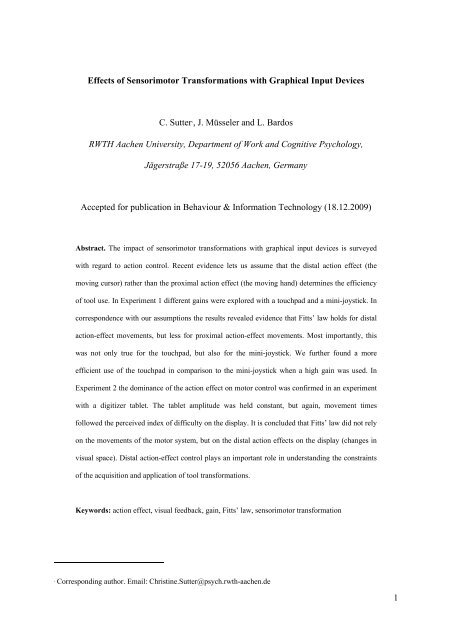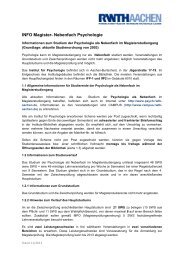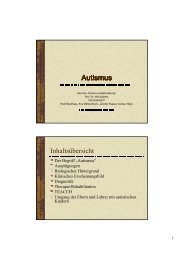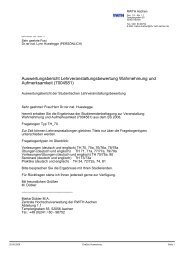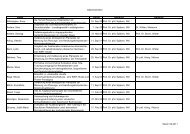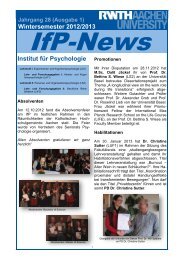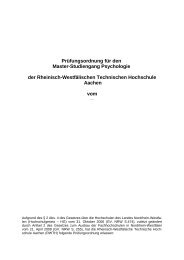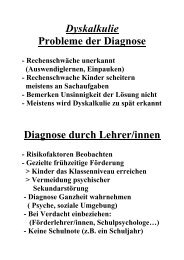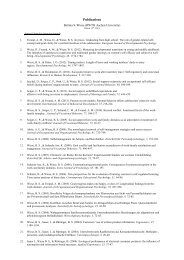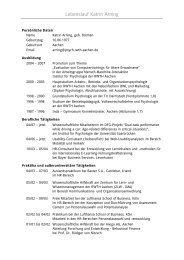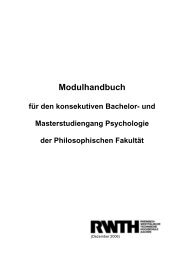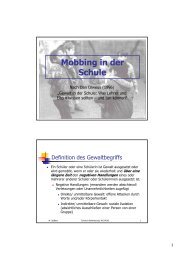1 Effects of Sensorimotor Transformations with Graphical Input ...
1 Effects of Sensorimotor Transformations with Graphical Input ...
1 Effects of Sensorimotor Transformations with Graphical Input ...
Create successful ePaper yourself
Turn your PDF publications into a flip-book with our unique Google optimized e-Paper software.
<strong>Effects</strong> <strong>of</strong> <strong>Sensorimotor</strong> <strong>Transformations</strong> <strong>with</strong> <strong>Graphical</strong> <strong>Input</strong> Devices<br />
C. Sutter ∗ , J. Müsseler and L. Bardos<br />
RWTH Aachen University, Department <strong>of</strong> Work and Cognitive Psychology,<br />
Jägerstraße 17-19, 52056 Aachen, Germany<br />
Accepted for publication in Behaviour & Information Technology (18.12.2009)<br />
Abstract. The impact <strong>of</strong> sensorimotor transformations <strong>with</strong> graphical input devices is surveyed<br />
<strong>with</strong> regard to action control. Recent evidence lets us assume that the distal action effect (the<br />
moving cursor) rather than the proximal action effect (the moving hand) determines the efficiency<br />
<strong>of</strong> tool use. In Experiment 1 different gains were explored <strong>with</strong> a touchpad and a mini-joystick. In<br />
correspondence <strong>with</strong> our assumptions the results revealed evidence that Fitts’ law holds for distal<br />
action-effect movements, but less for proximal action-effect movements. Most importantly, this<br />
was not only true for the touchpad, but also for the mini-joystick. We further found a more<br />
efficient use <strong>of</strong> the touchpad in comparison to the mini-joystick when a high gain was used. In<br />
Experiment 2 the dominance <strong>of</strong> the action effect on motor control was confirmed in an experiment<br />
<strong>with</strong> a digitizer tablet. The tablet amplitude was held constant, but again, movement times<br />
followed the perceived index <strong>of</strong> difficulty on the display. It is concluded that Fitts’ law did not rely<br />
on the movements <strong>of</strong> the motor system, but on the distal action effects on the display (changes in<br />
visual space). Distal action-effect control plays an important role in understanding the constraints<br />
<strong>of</strong> the acquisition and application <strong>of</strong> tool transformations.<br />
Keywords: action effect, visual feedback, gain, Fitts’ law, sensorimotor transformation<br />
∗<br />
Corresponding author. Email: Christine.Sutter@psych.rwth-aachen.de<br />
1
1. Introduction<br />
Tool use in modern work <strong>of</strong>ten challenges the human motor system, especially when the<br />
execution and observation <strong>of</strong> motor skills are spatially separated, and when transformations<br />
are in effect. The use <strong>of</strong> computer input devices is only one example in this respect. More<br />
elaborate tools are used for instance in laparoscopic surgery, Virtual Reality or teleoperation.<br />
Recent studies (Kunde, Müsseler & Heuer, 2008, Müsseler, Kunde, Gausepohl & Heuer,<br />
2008) give evidence that distal action effects (the moving cursor on the display) play the more<br />
essential role in controlling tools than proximal action effects (the moving hand). We aim to<br />
further the understanding <strong>of</strong> cognitive processes that mediates the usability <strong>of</strong> input devices.<br />
In two experiments we evaluate user behaviour towards changes in motor space and/or visual<br />
space. We will question, what is more important for controlling input devices successfully, to<br />
supervise one’s own hand or the cursor movement on the display? As a consequence changes<br />
in either motor space or visual space should have a predominant influence on performance.<br />
The findings will help to understand the constraints <strong>of</strong> the acquisition and application <strong>of</strong> tool<br />
transformations.<br />
<strong>Sensorimotor</strong> transformations <strong>with</strong> input-output devices differ in two aspects. Firstly,<br />
the input device manipulation (proximal effect) can or cannot correspond to the cursor action<br />
(distal effect). For example, most input devices (e.g. mouse, digitizer tablet, touchpad,<br />
displacement joystick or flystick) transform hand movements into cursor movements. The<br />
transformation is kept rather simple, i.e. the relationship between the moving hand and the<br />
cursor movement is obvious to the user. A considerable amount <strong>of</strong> studies (for an overview<br />
see Douglas & Mithal, 1997) reported a very efficient usage <strong>of</strong> motion-transforming input<br />
devices. Other input devices are rotary (e.g. trackball) or force-sensitive (e.g. isometric<br />
joystick or spacemouse). The transformation between applied rotation or force is less<br />
obviously connected to the cursor movement. Consequently, the user has more difficulties to<br />
2
anticipate the movement path, to control it and to terminate it successfully (e.g., Armbrüster,<br />
Sutter & Ziefle, 2007; Card, English & Burr, 1978; Douglas & Mithal, 1997; Epps, 1987;<br />
Sutter, 2007; Sutter & Müsseler, 2007).<br />
Secondly, when operating a device the user has to account for a considerable displaycontrol<br />
gain. Generally, performance is best when the hand movements nearly match the<br />
cursor movements (gains between 1:0.8 to 1:2). The missing concordance between one’s own<br />
action and the intended action’s effect (i.e. the cursor movement) account for interferences,<br />
and leads to increased movement times and/or errors for very low and high gains (for digitizer<br />
tablet see Accot & Zhai, 2001; Arnaut & Greenstein, 1986, 1990, for trackball see Arnaut &<br />
Greenstein, 1986, 1990; for mouse see Casiez et al., 2008; MacKenzie & Riddersma, 1994;<br />
Lin, Radwin & Vanderheiden, 1992; Tränkle & Deutschmann, 1991). The findings <strong>of</strong><br />
previous studies suggest that it is the concordance (discordance) between hand action and<br />
cursor movement that facilitates (hamper) performance. However, non <strong>of</strong> these studies<br />
conceptualized the usability <strong>of</strong> input devices <strong>with</strong> regard to action-effect control. Here, we<br />
provide a first step towards such a cognitive account in human-computer interaction. The<br />
theoretical basis will provide a better understanding <strong>of</strong> the cognitive strategies mediating the<br />
interaction in technical environments.<br />
Of course, pointing <strong>with</strong> a cursor to a certain position on a display requires always a<br />
corresponding hand movement (except for isometric devices), thus hand movement and<br />
cursor movement are usually confounded. But this does not necessarily imply that hand<br />
movement and cursor movement are equally represented and used in the same way for<br />
controlling movements. On the contrary, recent evidence lets us assume that the action effect<br />
is essential regarding these kinds <strong>of</strong> tool use. For example, Kunde and co-workers (Kunde et<br />
al., 2007; see also Müsseler et al., 2008) introduced a lever to reach at a stimulus <strong>with</strong> the<br />
lever’s effect point. Using different pivot points for the lever allowed dissociating effects<br />
3
etween proximal hand-movement direction and distal tool-movement direction. For<br />
example, when the effect point <strong>of</strong> the lever was in front <strong>of</strong> the pivot point and thus on the side<br />
<strong>of</strong> the hand, hand movement and effect movement corresponded. If it was beyond the pivot<br />
point, hand movement and effect movement were contrarily. The finding was that reactions<br />
were performed more efficiently when the tip <strong>of</strong> the tool was moved towards the stimulus,<br />
irrespective <strong>of</strong> the hand movement. This was clear evidence for the assumption that the<br />
intended action effect determines the response.<br />
What does this finding mean for tool use in modern workplaces? Take for example the<br />
laparoscopic surgery. Here, the surgeon inserts a tool through a tiny, artificial aperture in the<br />
patient’s torso. Although this operation technique has many advantages from a medical point<br />
<strong>of</strong> view, it creates severe problems for the surgeon as well. The aperture functions as a pivot<br />
and inverts the surgeon’s hand movement and tool movement direction, i.e. if the surgeon<br />
moves the hand to the right the tool tip inside the body moves to the left and vice versa. The<br />
results from Kunde and co-workers (Kunde et al., 2007) suggest, that what counts most in this<br />
situation is the representation <strong>of</strong> the distal action effect (i.e. tool tip moves towards stimulus),<br />
not the proximal effect (i.e. surgeon’s hand moves towards the stimulus). This finding is<br />
consistent <strong>with</strong> predictions proposed by the ideo-motor principle (Greenwald, 1970; James,<br />
1890; for recent overviews <strong>of</strong> empirical evidence see, e.g., Hommel, Müsseler, Aschersleben<br />
& Prinz, 2001; Nattkemper & Ziessler, 2004). Any intentional act requires a goal, that is,<br />
some anticipatory representation <strong>of</strong> the intended action effect. The anticipation <strong>of</strong> these action<br />
effects may fulfil a generative function in motor control: actors select, initiate, and execute a<br />
movement by activating the anticipatory codes <strong>of</strong> the movement’s effects. These may be<br />
representations <strong>of</strong> body-related effects, like tactile feedback from the moving hand operating<br />
a tool (proximal effects). However, the intended action effects when using a tool are the<br />
4
movements <strong>of</strong> the tool tip displayed on the screen (distal effects). As a consequence, they<br />
should play the more essential role in controlling a tool successfully.<br />
The present paper aims to explore if these conclusions will also hold for controlling<br />
input devices, especially when these tools are force-controlled and require no hand movement<br />
at all. In Experiment 1 we evaluated a touchpad and a mini-joystick. The touchpad is motioncontrolled<br />
and the mini-joystick is force-controlled. They represent the class <strong>of</strong> small input<br />
devices, integrated for example in mobile devices (camera, mobile phone, laptop computer) or<br />
in medical equipment (ultrasound system). Motor control is much more difficult when using<br />
small input devices due to restricted motor space (Accot & Zhai, 2001) and less inertia<br />
(Douglas & Mithal, 1997). So, effects from previous studies might be underestimated for<br />
these tools. We introduced changes in motor space and/or visual space by varying gain, target<br />
amplitude and size. We explored whether Fitts’ law (Fitts, 1954) would hold for cursor<br />
movements produced by touchpad and isometric mini-joystick in a comparable way. Of<br />
special interest in the present context was that the handling <strong>of</strong> the mini-joystick required no<br />
hand movement at all and that the cursor movements resulted only from the hand-force<br />
transformation. Nevertheless, the action-effect account claims that Fitts’ law holds for actioneffect<br />
movements (i.e. the cursor movements), irrespective <strong>of</strong> the input device and gain used.<br />
Reason for this is given by the very robust nature <strong>of</strong> the psychomotor law, which holds not<br />
only for all kinds <strong>of</strong> manual movements (e.g. finger, wrist, arm: Langolf, Chaffin & Foulke,<br />
1976), but also for movement imagination (e.g. Grosjean, Shiffrar & Knoblich, 2007) and<br />
transformed movements (e.g. mouse: Casiez et al., 2008; touchpad, mini-joystick: Sutter,<br />
2007), as long as the reference to the ballistic nature <strong>of</strong> rapid aimed movements is apparent.<br />
Experiment 2 tested the generalization <strong>of</strong> the findings <strong>with</strong> a digitizer tablet. ). In motioncontrolled<br />
input devices hand movement and cursor movement are usually confounded, so we<br />
introduced changes in visual space only. Although in this experiment the proximal hand<br />
5
movements were kept constant, Fitts’ law should again hold for the action-effect movements<br />
(i.e. the cursor movements) produced by different gains.<br />
2. Experiment 1<br />
<strong>Sensorimotor</strong> transformations <strong>of</strong> touchpad and mini-joystick are basically different and<br />
represent different classes <strong>of</strong> input devices. The touchpad is an isotonic device. Its gain is a<br />
function <strong>of</strong> finger motion to cursor motion. The mini-joystick represents an isometric device,<br />
i.e. the gain is a function <strong>of</strong> finger force to cursor speed. To compare device performance in a<br />
precisely and methodologically objective manner, a number <strong>of</strong> input and output factors have<br />
to be considered, e.g. differences in receptor-effector processes, sensitivity <strong>of</strong> device and<br />
cursor speed. In accordance <strong>with</strong> the action-effect account we expect the more corresponding<br />
input-output transformation <strong>of</strong> the touchpad to be used more efficiently than the less<br />
corresponding transformation <strong>of</strong> the mini-joystick. Also in accordance <strong>with</strong> the action-effect<br />
account we predict Fitts’ law to hold for cursor movements produced by the mini-joystick as<br />
well, although this input device does not require a translational movement <strong>of</strong> the hand.<br />
2.1 Method<br />
2.1.1 Pretest<br />
The experimental comparison <strong>of</strong> input devices <strong>with</strong> different input-output parameters reveals<br />
methodological problems. Note that the two input devices differ in several features too, apart<br />
from transforming finger motion (isotonic) and finger force (isometric) into cursor<br />
movements. These features are inherent properties <strong>of</strong> the devices and are not aimed at in the<br />
present study. However, to minimize the differences and to allow an experimental comparison<br />
<strong>of</strong> performance we measured the output parameters <strong>of</strong> each device and adjusted cursor speed<br />
on a similar level (for the methodology <strong>of</strong> the pretest in more detail see Sutter, 2007).<br />
6
Cursor velocity was measured when the maximum speed <strong>of</strong> finger movement<br />
(touchpad) or the maximum force <strong>of</strong> finger press (mini-joystick) was applied to the input<br />
device. The pretest was conducted for the touchpad and mini-joystick <strong>of</strong> a Dell Inspiron 8100<br />
laptop computer. For the duration <strong>of</strong> two minutes the cursor was moved as fast as possible<br />
horizontally on the display (N = 3 participants). This procedure was repeated for all eleven<br />
gain settings provided by the system (low to high). For each gain setting, cursor speed was<br />
calculated by the ratio <strong>of</strong> cursor movement to time.<br />
On the 11-point presetting scale the “low” gain settings (settings 1-3) resulted in a<br />
cursor speed below 1000 p/s, the “medium” (settings 4-6) between 1000 to 3500 p/s and the<br />
“high” setting (settings 7-11) in a cursor speed higher than 3500 p/s. In the present<br />
experiment we will focus on the “low” (3) and “high” (7) gain settings. Setting 3 resulted in a<br />
rather slow cursor movement on the screen, comparable to a cursor speed below the average<br />
mouse speed. A fast cursor speed was given <strong>with</strong> setting 7, which was above the average<br />
mouse speed found in desktop computers. For touchpad and mini-joystick, respectively, low<br />
gain (setting 3) resulted in a cursor speed at about 563 p/s and 970 p/s. Cursor speed was high<br />
(setting 7) at about 4565 p/s and 3760 p/s. Apparently, gain specifications as preset by the<br />
device drivers do provide an approximation <strong>of</strong> cursor speed between touchpad and minijoystick.<br />
2.1.2 Participants<br />
Twenty students from the RWTH Aachen University (5 male) volunteered for the study. They<br />
were all high experienced laptop users: 10 students used the touchpad (3 male) and 10<br />
students used the mini-joystick (2 male) as their regular graphical input device. Their<br />
expertise in operating the input device was determined by the daily contact hours <strong>with</strong> the<br />
laptop and the particular input device. All <strong>of</strong> them had been full-time laptop users for more<br />
7
than two years, <strong>with</strong> an average use <strong>of</strong> 2.7 hr/day (SD = 2.2). Expert groups did not differ<br />
according to their laptop habits (t-tests n.s.). It was controlled that experts <strong>with</strong> one input<br />
device were having no (or less) experience <strong>with</strong> the other input device.<br />
2.1.3 Apparatus and stimuli<br />
Participants sat in front <strong>of</strong> a laptop computer (Dell Inspiron 8100) that was connected to an<br />
external 15’’ TFT flat screen (Iiyama TXA 3841J) <strong>with</strong> a 1024 x 768 resolution. The input<br />
devices integrated in the laptop were a touchpad, a flat 60 x 44 mm touch sensitive panel and<br />
a mini-joystick, a small force-sensitive joystick placed between the “G”, “H” and “B” keys on<br />
the keyboard. Two mouse buttons were arranged horizontally in the wrist rest.<br />
On the display a cross-hair cursor and a target box were presented in black colour on<br />
white background. The point-click task included to move the cursor inside the target box, and<br />
to press the left mouse button. Target boxes appeared in two sizes (2.5 and 5.0 mm) and in<br />
two distances (25 and 50 mm). IDs according to Fitts’ law (ISO 9241-9, 2000; MacKenzie,<br />
1992) were 2.6, 3.5 and 4.4 bits. The target box was always located centrally. The starting<br />
position <strong>of</strong> the cursor was placed in eight different directions (45º, 90º, 135º, 180º, 225º, 270º,<br />
315º, and 360º) relative to the target excluding confounds <strong>with</strong> movement direction.<br />
2.1.4 Procedure<br />
Participants were assigned to two experimental conditions according to their expertise <strong>with</strong><br />
touchpad or mini-joystick. In the motion transformation condition all participants were<br />
exclusively experts <strong>with</strong> the touchpad and operated the touchpad throughout the experiment.<br />
In the force transformation condition participants were mini-joystick experts and solved the<br />
experimental point-click tasks by operating the mini-joystick. Each trial started <strong>with</strong> a selfpaced<br />
press <strong>of</strong> the space bar. The task was to move the cursor inside the target box and<br />
8
confirm the correct positioning by pressing the left mouse button. Participants were instructed<br />
to move the cursor as fast and accurate as possible, and to operate the input device <strong>with</strong> their<br />
dominant hand, the left mouse button <strong>with</strong> their non-dominant hand.<br />
The movement time was defined as the interval from onset <strong>of</strong> cursor movement to final<br />
button press. Error percentages were calculated on the basis <strong>of</strong> trials where the left mouse<br />
button was pressed when the cursor was not inside the target box. The participants worked<br />
throughout a block <strong>with</strong> low gain <strong>of</strong> the cursor (gain 3) and a block <strong>with</strong> high gain (gain 7).<br />
The order <strong>of</strong> the gain conditions was counterbalanced across participants. Each block<br />
consisted <strong>of</strong> 4 ID conditions (<strong>with</strong> 16 repetitions) and additional 10 training trials in advance<br />
<strong>of</strong> each block. In total, the experiment lasted 30 minutes.<br />
2.2 Results<br />
The data were analysed <strong>with</strong> a 2 x 2 x 3 analysis <strong>of</strong> variance (ANOVA) <strong>with</strong> the betweensubject<br />
factor “sensorimotor transformation” (movement vs. force transformation) and <strong>with</strong><br />
the <strong>with</strong>in-subject factors “cursor gain” (low vs. high) and “ID” (2.6, 3.5 and 4.4 bits). For<br />
movement times, the ANOVA revealed a significant main effect <strong>of</strong> the group factor<br />
“sensorimotor transformation” (F(1, 18) = 10.49; p < .01). Movements times were generally<br />
225 ms shorter <strong>with</strong> the touchpad than <strong>with</strong> the mini-joystick, but this advantage based on the<br />
high gain condition (Δ 377 ms; p < 0.01) and less on the low gain condition (n.s.), resulting in<br />
a significant interaction between sensorimotor transformation and cursor gain (F(1, 18) =<br />
22.35; p < .01). Movement times significantly decreased <strong>with</strong> the touchpad from the low gain<br />
to the high gain condition (1399 vs. 1162 ms; p < 0.01), while they remained nearly<br />
unaffected by gain change <strong>with</strong> the mini-joystick (1473 vs. 1539 ms; n.s.).<br />
-----insert Figure 1 about here-----<br />
9
Additionally, the main effects <strong>of</strong> the factors “cursor gain” (F(1, 18) = 7.14; p < .05)<br />
and “ID” (F(2, 17) = 353.13; p < .01) were significant. Movement times increased from the<br />
easiest (2.6 bits) to the most difficult task (4.4 bits). However, this increase <strong>of</strong> movement<br />
times was more pronounced in the low gain condition <strong>with</strong> an increase <strong>of</strong> 874 ms than in the<br />
high gain condition (increase <strong>of</strong> 633 ms) yielding a significant interaction between both<br />
factors <strong>with</strong> F(2, 17) = 20.18; p < .01. -- The analysis <strong>of</strong> the error percentages revealed no<br />
significant effects. Participants responded quite accurately <strong>with</strong> a mean error percentage<br />
below 5%.<br />
Data were further analysed <strong>with</strong> regard to effects <strong>of</strong> ID according to Fitts’ law (Fitts,<br />
1954). For each <strong>of</strong> the four gains by transformation conditions a separate regression analysis<br />
<strong>with</strong> the 4 ID conditions (= log 2 (A/W + 1); modified formula by MacKenzie, 1992) was<br />
calculated for movement time (Figure 1). In the low gain conditions slopes were different<br />
from zero (all <strong>with</strong> p ≤ .05) and they were comparable between touchpad and mini-joystick<br />
(482 ms/bits and 488 ms/bits). Intercepts did not differ significantly from zero. Overall,<br />
regression lines fit the data very well and ID accounted for most variance in movement time<br />
in the low (all R 2 above .95) and high gain conditions (all R 2 above .68).<br />
2.3 Discussion<br />
There were three main findings <strong>of</strong> Experiment 1. Firstly, the touchpad was used more<br />
efficiently than the mini-joystick when a high gain was used. At first glance —and in<br />
accordance <strong>with</strong> our hypotheses—the more demanding force transformation <strong>of</strong> the minijoystick<br />
seems to be inferior when compared <strong>with</strong> the motion transformation <strong>of</strong> the touchpad,<br />
especially when a higher gain was introduced. At second glance, however, results showed an<br />
impact <strong>of</strong> gain change on touchpad performance only. As observed for other motion<br />
transforming input devices (e.g., Accot & Zhai, 2001; Casiez et al., 2008; Jellinek & Card,<br />
10
1990) the gain change <strong>of</strong> the touchpad followed a half-parabola <strong>with</strong> an optimum for the<br />
higher gain condition. Remember, in the present experiment visual target sizes and distances<br />
were held constant. As a consequence low gain resulted in longer hand amplitudes on the pad<br />
and longer movement times than compared <strong>with</strong> those <strong>of</strong> high gain. More surprisingly, using<br />
a mini-joystick was totally unaffected by gain and performance remained stable for low and<br />
high gain settings. For now we can summarize that changes in motor space have an impact on<br />
motion transforming input devices, but not necessarily on force transforming devices.<br />
Secondly, the regression analysis <strong>of</strong> movement time and ID revealed that Fitts’ law<br />
holds for visually perceived action-effect movements, that is, for cursor movements on the<br />
display. Most importantly, this is not only true for the touchpad, but also for the mini-joystick,<br />
in which force is the input. Thus, Fitts’ law does not necessarily need movements <strong>of</strong> the<br />
motor system, but it holds for action-effect perception. In accordance <strong>with</strong> this finding,<br />
Grosjean and co-workers (Grosjean et al., 2007) found when observers judged ones’ other<br />
movements, they also tend to rate them <strong>with</strong> regard to Fitts’ law. This is additional evidence<br />
in favour <strong>of</strong> the action-effect account. However, one might argue that each regression line in<br />
Figure 1 is based only on three IDs, which do not provide a sufficient database. Therefore,<br />
Experiment 2 aimed to extend and generalize the findings.<br />
Third, the observed difference in movement times for similar IDs but different<br />
amplitude/width combinations is also in accordance <strong>with</strong> previous work (Sheridan, 1979;<br />
Sutter & Ziefle, 2004). Contrary to Fitts’ law, target size accounts for more variance in<br />
movement time than amplitude and –as a result– movements towards closer but smaller<br />
targets were executed slower than towards farther but larger targets.<br />
3. Experiment 2<br />
One result <strong>of</strong> the previous experiment was that Fitts’ law held for touchpad and mini-joystick.<br />
11
Since the use <strong>of</strong> the mini-joystick did not need a translational hand movement, but force, our<br />
findings strongly supported the view that the display movements were controlled and<br />
executed by the anticipated action-effect movements (see also Sutter & Ziefle, 2004, 2006).<br />
The question what user’s control is not answered that clearly, since hand movement and<br />
cursor movement were confounded in Experiment 1. Therefore, to replicate and extend the<br />
finding <strong>of</strong> visual action-effect control, a digitizer tablet was used in the present experiment<br />
<strong>with</strong> a Fitts’ task. Within a block <strong>of</strong> the experiment, participants always executed the same<br />
proximal movement on the digitizer tablet (no change in motor space), but the gains and/or<br />
the target sizes varied (changes in visual space only). Movement times should be constant<br />
<strong>with</strong>in a block if the proximal hand movement on the digitizer tablet actuates motor control.<br />
On the contrary, we expect them to vary <strong>with</strong> regard to Fitts’ law, if it is the distal action<br />
effect on the display (i.e. the cursor movement) that determines movement times.<br />
3.1 Method<br />
3.1.1 Participants<br />
Nine students from the RWTH Aachen University (6 male) participated in this experiment.<br />
3.1.2 Apparatus, task and stimuli<br />
Participants sat in front <strong>of</strong> a digitizer tablet (WACOM Intuos2 A3) that was operated <strong>with</strong> a<br />
pen (WACOM Intuos2 Grip Pen). Experimental tasks were presented on a 17’’ CRT display<br />
(EIZO F563-T) <strong>with</strong> a 1024 x 768 resolution. A cover screened the hands from the view.<br />
Participants were only able to see the display <strong>of</strong> the cursor movement, not the movements <strong>of</strong><br />
their hand on the digitizer tablet. The task involved moving the cursor back and forth between<br />
two target boxes that were horizontally displayed on the screen. Each trial lasted until 25<br />
error-free movements occurred.<br />
12
The movement distance <strong>of</strong> the hand (tablet amplitude) was the same for all trials<br />
<strong>with</strong>in a block (20, 40, or 60 mm). Within each block movement distance <strong>of</strong> the cursor<br />
(display amplitude) varied as a result <strong>of</strong> gain factor (1.22 [low gain], 1.44 [middle gain] and<br />
4.88 [high gain]): The display amplitude was 24 (low gain), 48 (middle gain), and 97 mm<br />
(high gain) <strong>with</strong>in the 20-mm block, 48, 97, and 195 mm <strong>with</strong>in the 40-mm block, and 73,<br />
146, and 292 mm <strong>with</strong>in the 60-mm block. Additionally, <strong>with</strong>in each block the target sizes<br />
varied randomly <strong>with</strong> 5, 10, 20, and 40 mm. The combination <strong>of</strong> 24-mm display amplitude<br />
and 40-mm target size in the 20-mm block was skipped from the procedure, as overlapping<br />
target boxes resulted. For display amplitude and display target size the index <strong>of</strong> difficulty was<br />
calculated using Fitts’ law (ID modification by MacKenzie, 1992). Display ID varied from<br />
1.2 to 4.4 bits (11 different A/W ratios) for the 20-mm block, from 1.2 to 5.4 bits (12 different<br />
A/W ratios) for the 40-mm block, and from 1.5 to 5.9 bits (12 different A/W ratios) for the<br />
60-mm block.<br />
3.1.3 Procedure and design<br />
Participants were instructed to continuously move the cursor back and forth between the two<br />
target boxes. As soon as they reached one target box the movement direction should be<br />
reversed <strong>with</strong>out pausing in the target box. The instruction stressed the need to move<br />
continuously, and to move as fast and turn as accurately as possible.<br />
The movement time was defined as the time for each target-to-target movement. Error<br />
percentages were calculated on the number <strong>of</strong> trials, where the reversal point <strong>of</strong> movement<br />
was outside the target box. The participants worked throughout the three blocks <strong>of</strong> tablet<br />
amplitudes. The order <strong>of</strong> blocks was counterbalanced across participants. Within a block, gain<br />
and target size were randomly varied. Each block consisted <strong>of</strong> 11 or 12 A/W combinations<br />
13
<strong>with</strong> 25 repetitions and additional 3x25 training trials in advance <strong>of</strong> the experimental trials. In<br />
total, the experiment lasted about 45 minutes.<br />
3.2 Results<br />
Blocks <strong>of</strong> tablet amplitudes were analysed <strong>with</strong> separate ANOVAs <strong>with</strong> the <strong>with</strong>in-subject<br />
factors “gain” (low, middle, and high) and “target size” (5, 10, 20, and 40 mm). For all tablet<br />
amplitudes a comparable pattern <strong>of</strong> results was found (Figure 2). Movement times and error<br />
percentages were increased <strong>with</strong> the high gain compared to the low and middle gain. In all<br />
gain conditions movement times and error percentages were lowest for the largest target and<br />
increased as a function <strong>of</strong> target size. Movement times increased from 301 ms to 519 ms <strong>with</strong><br />
the 20-mm tablet amplitude (Figure 2 top), from 404 ms to 797 ms <strong>with</strong> the 40-mm tablet<br />
amplitude (Figure 2 middle) and from 514 ms to 976 ms <strong>with</strong> the 60-mm tablet amplitude<br />
(Figure 2 bottom). Corresponding effects were observed in the errors: Error percentages<br />
increased from 1 to 19% <strong>with</strong> the 20-mm tablet condition, from 3 to 22% <strong>with</strong> the 40-mm<br />
tablet condition and from 3 to 25% <strong>with</strong> the 60-mm tablet condition.<br />
-----insert Figure 2 about here-----<br />
The ANOVA <strong>of</strong> movement times revealed consistently significant main effects <strong>of</strong> the<br />
factors “gain” (20 mm: F(2, 7) = 57.66; p < .01; 40 mm: F(2, 7) = 43.80; p < .01 and 60 mm:<br />
F(2, 7) = 33.99; p < .01) and “target size” (20 mm: F(3, 6) = 48.40; p < .01; 40 mm: F(3, 6) =<br />
32.10; p < .01; 60 mm: F(3, 6) = 53.93; p < .01). The interactions were always not significant.<br />
Corresponding effects were observed in the ANOVA <strong>of</strong> error percentages for gain (20<br />
mm: F(2, 7) = 18.22; p < .01; 40 mm: F(2, 7) = 24.05; p < .01; 60 mm: F(2, 7) = 21.05; p <<br />
.01) and target size (20 mm: F(3, 6) = 7.90; p < .05; 40 mm: F(3, 6) = 20.44; p < .01; 60 mm:<br />
F(3, 6) = 20.52; p < .01). For the tablet amplitude <strong>of</strong> 60 mm the interaction <strong>of</strong> gain and target<br />
size was also significant (F(6, 3) = 9.01; p < .05).<br />
14
Data were further analysed <strong>with</strong> regression analyses. For each tablet amplitude<br />
separate regression lines were calculated between movement time and ID (<strong>with</strong> 11 and 12<br />
different A/W ratios; Figure 3). Slopes were different from zero (all <strong>with</strong> p ≤ .001) and<br />
increased <strong>with</strong> tablet amplitude (from 129 to 153 and 174 ms/bits for the tablet amplitudes <strong>of</strong><br />
20, 40 and 60 mm, respectively). The intercept differed significantly from zero in the<br />
conditions <strong>with</strong> the 20-mm (p < .05) and 40-mm tablet amplitude (p < .01). Over all,<br />
regression lines fit the data very well (all R 2 above .94). The regression analysis <strong>with</strong> tablet<br />
amplitude, target size and gain accounted for most variance <strong>of</strong> movement time (R 2 = .88) <strong>with</strong><br />
MT = 151 ms + 94 ms/cm A tablet – 99 ms/cm W display + 72 ms/unit Gain. Intercept and slopes<br />
differed significantly from zero (p < .01). Within a given ID movement times were lowest if<br />
the gain was 1:2.44 and increased if gain was below (1:1.22) or above (1:4.88) that optimum.<br />
-----insert Figure 3 about here-----<br />
Separate regression lines were also calculated between error percentage and ID.<br />
Slopes differed from zero (all <strong>with</strong> p < .01) and decreased <strong>with</strong> tablet amplitude (from 10 (20<br />
mm) to 8%/bits (40 and 60 mm)). The intercept differed significantly from zero (all <strong>with</strong> p <<br />
.01) and decreased <strong>with</strong> tablet amplitude (from -14 (20 and 40 mm) to -16%/bits (60 mm)).<br />
Over all, regression lines fit the data very well (all R 2 above .82). The regression analysis <strong>with</strong><br />
tablet amplitude, target size and gain accounted for most variance <strong>of</strong> errors (R 2 = .80) <strong>with</strong><br />
MT = 2% + 1 %/cm A tablet – 5 %/cm W display + 5 %/unit Gain. Slopes differed significantly<br />
from zero (p < .05). Within a given ID error percentages were lowest if the gain was between<br />
1.22 and 2.44 and increased if the gain was above that optimum (4.88).<br />
3.3 Discussion<br />
We can conclude in accordance <strong>with</strong> our assumptions and the findings <strong>of</strong> Experiment 1 that it<br />
was the target distance and the target size on the display that determined movement times. In<br />
15
other words, as tablet amplitudes were held constant in each panel <strong>of</strong> Figure 2, Fitts’ law<br />
holds again for the action-effect movements on the display (i.e. the cursor movements).<br />
Performance was best if the gain was 2.44 and dropped <strong>with</strong> lower or higher gains. Once<br />
more, this result confirms the optimum gain setting for motion transforming input devices (cf.<br />
Arnaut & Greenstein, 1986, 1990; Lin et al., 1992; Tränkle & Deutschmann, 1991).<br />
A further observation <strong>of</strong> the present experiment was that participants were mostly<br />
unaware <strong>of</strong> their tablet amplitude. Informal reports gathered after the experiment revealed that<br />
participants did not notice that the hand amplitude remained constant <strong>with</strong>in a block and only<br />
display amplitude was varied by a change in the gain. In other words, the proprioceptive<br />
feedback <strong>of</strong> the hand movement did not countervail against the visual action effect (cf.<br />
Müsseler & Sutter, 2009).<br />
Two aspects are critical to note. First, the cursor movements on the display did not<br />
only determine movement times, but they also depended strongly on the tablet amplitude.<br />
Comparing the panels <strong>of</strong> Figure 2, larger tablet amplitudes seemed to lead to an increase in<br />
movement times. One might argue that for the smaller tablet amplitudes movements involve<br />
distal joints (e.g. finger, wrist), which produce shorter movement times. Contrary, for larger<br />
tablet amplitudes movements involve proximal joints (e.g. arm) yielding longer movement<br />
times (Langolf et al., 1976; Bohan, Thompson & Samuelson, 2003). However, in our<br />
experiment participants were able to cover all distances <strong>with</strong> wrist movements, even the<br />
longest distance <strong>of</strong> 60 mm. This lets us conclude that the increase <strong>of</strong> hand amplitude<br />
intensified the impact <strong>of</strong> changes in visual space. And furthermore, if distal joints were<br />
involved even stronger effects on movement time can be expected.<br />
Second, the increase in movement times is not just described by an additive<br />
component, as the different slopes <strong>of</strong> regression lines in Figure 3 suggest. When additionally<br />
error percentages were taken into account, we found an increase <strong>of</strong> errors <strong>with</strong> the larger<br />
16
tablet amplitudes. This further increased movement time. In other words, if participants had<br />
worked more accurately then the increase in movement times would have been stronger as<br />
observed in the present data. Thus, one could even assume that the differences in slopes are<br />
rather underestimated than overestimated.<br />
4. General Discussion<br />
The present paper aimed to examine the question what the user controls when using an input<br />
device: the hand movement or the cursor movement. With regard to the action-effect account<br />
(Hommel et al., 2001) the intended action effects are achieved by the cursor movements on<br />
the display (distal effect). Consequently, we assumed that the cursor movements could play<br />
the more essential role in controlling an input device. The main finding <strong>of</strong> Experiment 1 was<br />
that Fitts’ law holds for visually perceived action-effect movements, that is, for the cursor<br />
movements on the display. Most importantly, this was also true when the mini-joystick was<br />
used which required no translational movement <strong>of</strong> the hand. Obviously, Fitts’ law did not<br />
need the movements <strong>of</strong> the hand, but the action-effect movements on the display. This finding<br />
was elaborated in Experiment 2. Participants performed a Fitts’ task on a digitizer tablet <strong>with</strong><br />
a pen <strong>with</strong>out seeing their hand. Within each block <strong>of</strong> the experiment, participants always<br />
performed the same movement amplitude <strong>with</strong> their hand, while the amplitude on the display<br />
was changed by various gains. Results demonstrated that movement times varied <strong>with</strong> the<br />
amplitude and the target size on the display. Again, it was Fitts’ ID calculated from display<br />
values that determined movement times.<br />
When movements are represented and controlled by anticipating the distal movement<br />
effects, participants need to be less aware <strong>of</strong> their own hand movements (cf. the informal<br />
reports <strong>of</strong> the participants in Experiment 2; see also Müsseler & Sutter, 2009). The present<br />
findings revealed further evidence for the dominance <strong>of</strong> the distal action effects (i.e. the<br />
17
cursor movement on the display) over the proximal action effects (i.e. the hand movement on<br />
touchpad and digitizer tablet, or hand force applied to the mini-joystick). This view makes<br />
sense, as it is a precondition for using tools successfully. If distal and proximal effects would<br />
be equally important in information processing, any deviation between them would be a<br />
steady source <strong>of</strong> interference. To void this interference, actions should be represented by the<br />
action effects and thus by the laws which establish them.<br />
As outlined in the Introduction, the understanding <strong>of</strong> cognitive processes underlying<br />
tool use becomes increasingly important. Modern technologies progressively create<br />
workplaces in which movement execution and observation are spatially separated. Computer<br />
input devices are only an example in this respect. More challenging workplaces in which<br />
users act by technical equipment in a distant space are –for instance– laparoscopic surgery,<br />
Virtual Reality (VR; for training or product development) or teleoperation. Recent studies<br />
more and more revealed that what counts most for controlling movements successfully are the<br />
action effects in distant space (e.g., Kunde et al., 2007; Lukas, Brau & Koch, in press; Massen<br />
& Prinz, 2008; Müsseler et al., 2008).<br />
A second finding <strong>of</strong> Experiment 1 was that the impact <strong>of</strong> gain change was only<br />
apparent when using the motion transforming device (touchpad), but not when using the force<br />
transforming one (mini-joystick). Importantly, both input devices were handled by highly<br />
experienced users, which excludes that the discrepancies between devices are a matter <strong>of</strong><br />
exercise. Instead, Fitts’ law has to be taken into account, which is determined by the physical<br />
hand movement on the touchpad, but not by the finger press on the mini-joystick. It becomes<br />
obvious that the motion-transforming input device is additionally affected by changes in<br />
motor space, but the force-transforming device is not. Thus, if proximal target distance and<br />
size becomes shorter and larger, respectively, faster responses occur <strong>with</strong> the touchpad.<br />
Blanch and co-workers (Blanch et al., 2004) also found effects <strong>of</strong> ID in motor space and in<br />
18
visual space when performing movements on a digitizer tablet. With reference to our results<br />
we conclude that the concordance between proximal action effects (proprioceptive, tactile<br />
feedback from the moving hand) and distal action effects (moving tool) facilitate<br />
performance. However, we --more or less automatically-- compensate for and adapt to smaller<br />
discordances (e.g., Rieger, Knoblich & Prinz, 2005). Larger discrepancies, as perceived <strong>with</strong><br />
extreme gain changes (very low, very high) or unfamiliar transformations (force into speed or<br />
left into right transformations) produce interferences (e.g., gain transformations: Accot &<br />
Zhai, 2001; Jellinek & Card, 1990; transformation <strong>with</strong> changes in movement direction: e.g.,<br />
Kunde et al., 2007; Müsseler et al., 2008; force transformations: Lukas et al., in press; Sutter,<br />
2007).<br />
In sum, the present experiments allow theoretical and practical conclusions for a better<br />
understanding <strong>of</strong> controlling input devices or tools <strong>with</strong> sensorimotor transformations in<br />
technical environments. Based on the cognitive account <strong>of</strong> action-effect control (Hommel et<br />
al., 2001) our results revealed evidence that distal action effects are predominant in action<br />
control. In other words, supervising the cursor movement on the display plays a more<br />
essential role in controlling an input device than supervising one’s own hand. However, the<br />
concordance or discordance between distal and proximal action effects is still able to facilitate<br />
or hamper performance.<br />
Acknowledgments<br />
We wish to thank Rafael Ballagas, Jan Borchers, Eva Fortmann, Eva-Maria Skottke, Michael Wagner and<br />
Martina Ziefle for supporting this research. This research was supported by a grant from the German Science<br />
Foundation to both authors (DFG Su 494/4).<br />
19
References<br />
Accot, J. and Zhai, S., 2001. Scale effects in steering law tasks. In Proceedings <strong>of</strong> the ACM<br />
CHI 2001 Conference on Human Factors in Computing Systems, 1, pages 1-8.<br />
Armbrüster, C., Sutter, C. and Ziefle, M., 2007. Notebook input devices put to the age test:<br />
The usability <strong>of</strong> trackpoint and touchpad for middle-aged adults. Ergonomics, 50 (3), 426-<br />
445.<br />
Arnaut, L. Y. and Greenstein, J. S., 1986. Optimizing the Touch Tablet: The <strong>Effects</strong> <strong>of</strong><br />
Control-Display Gain and Method <strong>of</strong> Cursor Control. Human Factors, 28 (6), 717-726.<br />
Arnaut, L. Y. and Greenstein, J. S., 1990. Is display/control gain a useful metric for<br />
optimizing an interface? Human Factors, 32 (6), 651-663.<br />
Blanch, R., Guiard, Y. and Beaudouin-Lafon, M., 2004. Semantic pointing: Improving target<br />
acquisition <strong>with</strong> control-display ratio adaptation. In Proceedings <strong>of</strong> the ACM CHI 2004<br />
Conference on Human Factors in Computing Systems, 6, pages 519-526.<br />
Bohan, M., Thompson, S. G. and Samuelson, P.J., 2003. Kinematic analysis <strong>of</strong> mouse cursor<br />
positioning as a function <strong>of</strong> movement scale and joint set. In: Proceedings <strong>of</strong> the 8 th<br />
Annual International Conference on Industrial Engineering, 442-447.<br />
Card, S. K., English, W. K., and Burr, B. J., 1978. Evaluation <strong>of</strong> mouse, rate-controlled<br />
isometric joystick, step keys and text keys for selection tasks on a CRT. In: R. Baecker and<br />
W. Buxton, eds. Readings in Human-Computer Interaction. San Mateo, CA: Morgan<br />
Kaufmann, 386-392.<br />
Casiez, G., Vogel, D., Balakrishnan, R. and Cockburn, A., 2008. The impact <strong>of</strong> controldisplay<br />
gain on user performance in pointing tasks. Human-Computer Interaction, 23, 215-<br />
250.<br />
Douglas, S. A. and Mithal, A. K., 1997. The ergonomics <strong>of</strong> computer pointing devices.<br />
London: Springer.<br />
20
Epps, B.W., 1986. Comparison <strong>of</strong> six cursor control devices based on Fitts Law models. In:<br />
Proceedings <strong>of</strong> the Annual Meeting <strong>of</strong> the Human Factors Society. Santa Monica, CA:<br />
Human Factors Society, 327-331.<br />
Fitts, P. M., 1954. The information capacity <strong>of</strong> the human motor system in controlling the<br />
amplitude <strong>of</strong> movement. Journal <strong>of</strong> Experimental Psychology, 47, 381-391.<br />
Graham, E. D., 1996. Virtual pointing on a computer display: Non-linear control-display<br />
mappings. Graphics Interface ‘96, 39-46.<br />
Greenwald, A. G., 1970. Sensory feedback mechanisms in performance control: With special<br />
reference to the ideo-motor mechanism. Psychological Review, 77, 73-99.<br />
Grosjean, M., Shiffrar, M., and Knoblich, G., 2007. Fitts's law holds for action perception.<br />
Psychological Science, 18 (2), 95-99.<br />
Hommel, B., Müsseler, J., Aschersleben, G. and Prinz, W., 2001. The theory <strong>of</strong> event coding<br />
(TEC): A framework for perception and action. Behavioral and Brain Sciences, 24, 869-<br />
937.<br />
ISO 9241-9, 2000. Ergonomic requirements for <strong>of</strong>fice work <strong>with</strong> visual display terminals.<br />
Part 9: Requirements for non-keyboard input devices. International Organisation <strong>of</strong><br />
Standardisation.<br />
James, W., 1890. The principles <strong>of</strong> psychology. New York, NY: Dover.<br />
Jellinek, H. D and Card, S. K., 1990. Powermice and user performance. In Proceedings <strong>of</strong> the<br />
ACM CHI ’90 Conference on Human Factors in Computing Systems, pages 213-220.<br />
Kunde, W., Müsseler, J. and Heuer, H., 2007. Spatial compatibility effects <strong>with</strong> tool use.<br />
Human Factors, 49 (4), 661-670.<br />
Langolf, G. D., Chaffin, D. B. and Foulke, J. A., 1976. An investigation <strong>of</strong> Fitts Law using a<br />
wide range <strong>of</strong> movement amplitudes. Journal <strong>of</strong> Motor Behavior, 2, 113-128.<br />
21
Lin, M. L., Radwin, R. G. and Vanderheiden, G. C., 1992. Gain effects on performance using<br />
a head-controlled computer input device. Ergonomics, 35 (2), 159-175.<br />
Lukas, S., Brau, H. and Koch, I., in press. Anticipatory movement compatibility for virtual<br />
reality interaction devices. Behaviour & Information Technology.<br />
MacKenzie, I. S., 1992. Fitts’ Law as a Research and Design Tool in Human-Computer<br />
Interaction. Human-Computer Interaction, 7, 91-139.<br />
MacKenzie, I. S. and Riddersma, S., 1994. <strong>Effects</strong> <strong>of</strong> output display and control-display gain<br />
on human performance in interactive systems. Behaviour & Information Technology, 13,<br />
328-337.<br />
Massen, C. and Prinz, W., 2008. Programming tool-use actions. Journal <strong>of</strong> Experimental<br />
Psychology: Human Perception and Performance, 33(3), 692–704<br />
Müsseler, J., Kunde, W., Gausepohl, D. and Heuer, H., 2008. Does a tool eliminate spatial<br />
compatibility effects? European Journal <strong>of</strong> Cognitive Psychology, 20, 211-231.<br />
Müsseler, J. and Sutter, C., 2009. Perceiving one's own movements when using a tool.<br />
Consciousness and Cognition, 18, 359-365.<br />
Nattkemper, D. and Ziessler, M., 2004. Cognitive control <strong>of</strong> action: The role <strong>of</strong> action effects.<br />
Psychological Research, 68, 71-73.<br />
Rieger, M., Knoblich, G. and Prinz, W., 2005. Compensation for and adaptation to changes in<br />
the environment. Experimental Brain Research, 163, 487-502.<br />
Sheridan, M.R., 1979. A repraisal <strong>of</strong> Fitts Law. Journal <strong>of</strong> Motor Behavior, 11 (3), 179-188.<br />
Sutter, C., 2007. Sensumotor transformation <strong>of</strong> input devices and the impact on practice and<br />
task difficulty. Ergonomics, 50 (12), 1992-2009.<br />
Sutter, C. and Müsseler, J., 2007. User specific design <strong>of</strong> interfaces and interaction<br />
techniques: What do older computer users need? In: C. Stephanidis, ed. Coping <strong>with</strong><br />
diversity in universal access, LNCS 4554. Heidelberg: Springer, 1020-1029.<br />
22
Sutter, C. and Ziefle, M., 2004. Psychomotor efficiency in users <strong>of</strong> notebook input devices:<br />
Confirmation and restrictions <strong>of</strong> Fitts law as an evaluative tool for user-friendly design. In:<br />
Proceedings <strong>of</strong> the Human Factors and Ergonomics Society 48th Annual Meeting. Santa<br />
Monica, CA: Human Factors and Ergonomics Society, 773-777.<br />
Sutter, C. and Ziefle, M., 2006. Psychomotor performance <strong>of</strong> input device users and<br />
optimized cursor control. In: Proceedings <strong>of</strong> the Human Factors and Ergonomics Society<br />
50th Annual Meeting. Santa Monica, CA: Human Factors and Ergonomics Society, 742-<br />
746.<br />
Tränkle, U. and Deutschmann, D., 1991. Factors influencing speed and precision <strong>of</strong> cursor<br />
positioning using a mouse. Ergonomics, 34 (2), 161-174.<br />
23
Figure Captions<br />
Figure 1. Mean movement times (ms) as a function <strong>of</strong> ID (bits) and gain for the touchpad and<br />
mini-joystick (Experiment 1).<br />
Figure 2. Mean movement times (grey) and percentage <strong>of</strong> errors (black) as a function <strong>of</strong> target<br />
size (mm) and gain for the tablet amplitudes 20, 40 and 60 mm (from top to bottom)<br />
(Experiment 2).<br />
Figure 3. Mean movement times (ms) as a function <strong>of</strong> ID (bits) for the tablet amplitudes 20,<br />
40 and 60 mm (Experiment 2).<br />
24
Touchpad – low gain<br />
MT = -294 ms + 482 ms/bits ID<br />
Trackpoint – low gain<br />
MT = -246 ms + 488 ms/bits ID<br />
------ Touchpad – high gain<br />
MT = -37 ms + 343 ms/bits ID<br />
------ Trackpoint – high gain<br />
MT = 284 ms + 360 ms/bits ID
Mean Movement Time<br />
(ms)<br />
1400<br />
1200<br />
1000<br />
800<br />
600<br />
400<br />
200<br />
0<br />
5 10 20 40 5 10 20 40 5 10 20 40<br />
200<br />
150<br />
100<br />
50<br />
0<br />
Error Rate (%)<br />
Target Size<br />
Low Gain<br />
Target Size<br />
Middle Gain<br />
Target Size<br />
High Gain<br />
Tablet Amplitude: 20 mm<br />
Mean Movement Time<br />
(ms)<br />
1400<br />
1200<br />
1000<br />
800<br />
600<br />
400<br />
200<br />
0<br />
5 10 20 40 5 10 20 40 5 10 20 40<br />
200<br />
150<br />
100<br />
50<br />
0<br />
Error Rate (%)<br />
Target Size<br />
Low Gain<br />
Target Size<br />
Middle Gain<br />
Target Size<br />
High Gain<br />
Tablet Amplitude: 40 mm<br />
Mean Movement Time<br />
(ms)<br />
1400<br />
1200<br />
1000<br />
800<br />
600<br />
400<br />
200<br />
0<br />
5 10 20 40 5 10 20 40 5 10 20 40<br />
200<br />
150<br />
100<br />
50<br />
0<br />
Error Rate (%)<br />
Target Size<br />
Low Gain<br />
Target Size<br />
Middle Gain<br />
Target Size<br />
High Gain<br />
Tablet Amplitude: 60 mm
Tablet Amplitude<br />
20 mm<br />
40 mm<br />
60 mm<br />
Index <strong>of</strong> Difficulty (bits)


